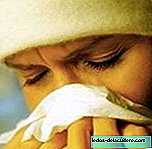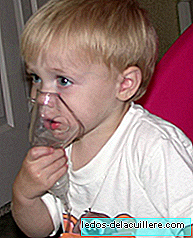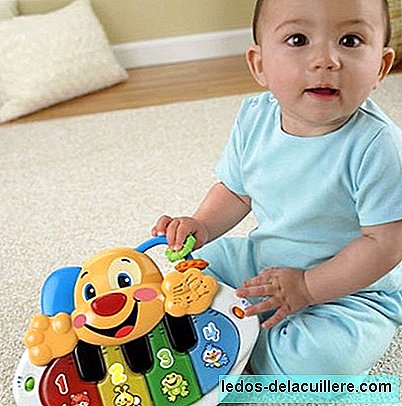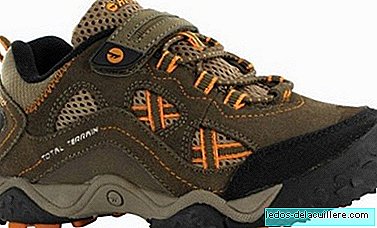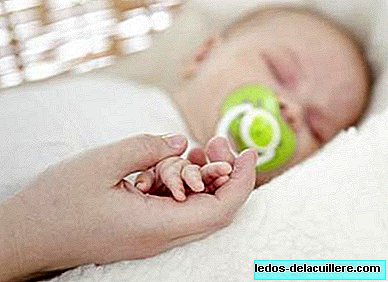
Sudden infant death syndrome is defined as the sudden and unexpected death of a child under one year of age. The autopsy does not reveal an explainable cause of death. This is a death very feared by parents, since it has no symptoms, notices or has a clear explanation.
But although the cause of sudden infant death is unknown, at present, many doctors and researchers believe that there are many factors involved, which we will discuss.
For example, the underdeveloped ability of the baby to wake up, as well as the inability of the baby's body to detect accumulation of carbon dioxide in the blood. The SMSL could originate as a failure in the micro-awakening before an episode of prolonged apnea, bradycardia or hypotension, arrhythmias or external situations that can lead to asphyxiation, that is, there is no response to a life threatening stimulus during sleep.
This happens especially between two and four months, when the risk of sudden infant death is highest. The SIDS is infrequent during the first month of life, after four months it decreases and after 12 months it is considered that the risk has virtually disappeared (then, it is referred to as "sudden death of the child").
It is also known that this syndrome happens more to boys than girls and more cases occur in winter. However, there is no "warning" of any kind: in sudden infant death the baby normally sleeps and death occurs during sleep.
Before moving on to the factors involved, we leave the definition of "sudden infant death" found in a 2004 study published in 'Pediatrics' on this concept, defined for the first time in 1969:
Sudden death of a child under one year of age, which occurs apparently during sleep and remains unexplained after conducting a thorough postmortem investigation, which includes the practice of autopsy, examination of the place of death and review of The medical history.

Factors related to sudden death
There are some factors that could be involved in the increased risk of sudden death, although the importance of each one is unknown and the causes are still being investigated. These are some of the factors:
Sleeping on your stomach. Therefore, since parents are recommended to put their babies to sleep on their backs or on their sides, cases of sudden infant death syndrome have decreased worldwide. It is estimated that in industrialized countries, the incidence of SIDS has decreased below 1/1000 newborns.
Being in an environment with cigarette smoke while in the womb or after birth. It is estimated that the risk of sudden infant death syndrome in smoking mothers during pregnancy is three times higher than that of non-smokers. This could explain the importance of the presence of carbon dioxide in the blood in relation to the problem.
The soft surfaces of beds, cribs, sofas ...
Mothers who smoke or consume psychoactive substances (alcohol, drugs, psychodepressants ...) that affect the central nervous system.
The major risk factors for SIDS decrease micro-awakenings (prone position face down, maternal smoking, head covered, apnea, hyperthermine).
According to the United States Medical Library, also The following points would be related to sudden infant death:
- Multiple births (being a twin, triplet, etc.).
- Premature births
- Having a brother or sister who suffered from SIDS.
- Born of a teenage mother.
- Short time intervals between pregnancies.
- Late prenatal care or absence of it.
- Live in conditions of poverty.
- Sleep in the same bed with your parents (sleep accompanied).
Regarding this last factor, the relationship between colecho and sudden death, this is a controversial issue.
The Initiative for the Humanization of Birth Assistance and Breastfeeding recently made a statement in which they indicate studies that have concluded, after an exhaustive review on breastfeeding, breastfeeding and sudden infant death, that the school is a beneficial practice for breastfeeding . And, in short, that the well-practiced colecho, avoiding risk factors, would not be related to the sudden death of the infant.
However, pediatric associations and organizations recommend avoiding school by relating it to sudden infant death and instead practicing "cohabitation," that is, sleep in the same room as the baby, being in a crib or crib attached to the parents' bed.
The latest recommendations of the Spanish Association of Pediatrics, which we can read in a consensus document on breastfeeding, breastfeeding and sudden infant death syndrome, prepared by the Breastfeeding Committee and the Working Group for the Study of Sudden Infant Death indicates that the safest way to sleep for babies is in their crib, on their backs and near their parents' bed.
For its part, the American Academy of Pediatrics also points out the dangers of sleeping in the same bed and recommends that the baby be in the same room, near the mother:
Babies who sleep in the same bed as their parents are at risk of SIDS, suffocation or strangulation. Parents can turn around and stay on babies while they sleep, or babies can get entangled in sheets or blankets.
In any case, remember how to practice colecho safely, with the advice listed below on how to reduce the risk of sudden infant death, most of which are used for colecho and other forms of sleep.

Reduce the risk of sudden infant death
The American Academy of Pediatrics recommends the following for reduce the risk of sudden infant death syndrome:
Always put the baby to sleep on his back (even during naps). Do not put a baby to sleep on his stomach during the first year of life. However, if your baby has turned and turned on its side or upside down on its own, you can leave it in that position if it can already turn from face down to face up and vice versa. If your baby falls asleep in a car seat, a walker, a swing, a baby carrier or a marsupium, you should pass it to a firm surface as soon as possible.
Put babies to sleep on a firm surface (such as a crib). Cot, bassinet, strollers ... must comply with current safety standards, not be old products recalled ... And of course not use broken, defective or incomplete cribs.
Cover the firm mattress with a fitted sheet. Do not place blankets or pillows between the mattress and the fitted sheet. Never put the baby to sleep in a chair, a sofa (it is considered a dangerous place for a baby to sleep), a water bed, a cushion, or a sheepskin blanket.
Keep soft objects, loose bedding or any other object that may increase the risk that the baby will be trapped, suffocated or strangulated out of the cradle. Pillows, bedspreads, quilts, fur blankets, protective cushions and stuffed toys can make your baby suffocate. Most experts agree that after twelve months of life, these objects pose a low risk for healthy babies, although there are no conclusive studies in this regard.
It is recommended to put the baby to sleep in the same room where the parents sleep, but not in the same bed. You have to keep the crib or bassinet near the bed, so that you can reach the baby easily: so you can easily observe or breastfeed your baby if you have it nearby.
Breastfeed the baby as much as you can and for as long as you can. Studies show that breastfeeding your baby can help reduce the risk of SIDS, perhaps because breastfeeding decreases some upper respiratory infections that can influence the presentation of this syndrome.
We must ensure that the baby is not too hot, keeping the room in which he sleeps (we sleep) at a comfortable temperature. If you are worried that the baby is cold, we can use baby bedding designed to keep them warm without the risk of covering their heads.
You may be offered a pacifier at bedtime, which helps reduce the risk of SIDS. Wait until breastfeeding is secured to offer a pacifier (about three to four weeks). Some babies do not like to use it. If your baby takes the pacifier and drops it after he falls asleep, he doesn't have to put it back in his mouth.
Keep the baby away from smokers and places where people smoke. Try smoking and until you can, keep the car and home smoke free. There is also no smoking near the baby, even if it is outdoors.
Cardiorespiratory home monitors should not be used to help reduce the risk of SIDS. These may be useful for babies with respiratory or heart problems, but they have not been proven to reduce this problem.
In general, products that claim to reduce the risk of SIDS should not be used (subject to babies, positioners, special mattresses and special sleeping surfaces ...) since they have not been shown to reduce the risk. In addition, some babies have suffocated while using these products.
We hope that with this review on what is sudden infant death and advice to reduce risk they are useful to you and you spend the nights in family more calm and safe.



